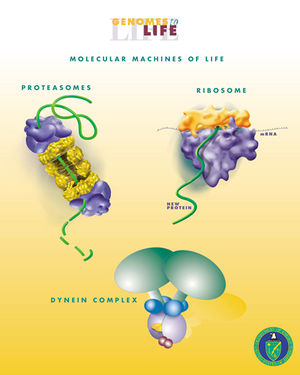Molecular machine
A molecular machine,[1] or nanomachine, is any set of molecules which produce mechanical movements (output) in response to specific stimuli (input).[2][3] The term is common in nanotechnology where a number of complex molecular machines have been proposed which might be a way of making a "molecular assembler". Molecular machines can be divided into two broad categories: synthetic and biological.
The 2016 Nobel Prize in Chemistry was awarded to Jean-Pierre Sauvage, Fraser Stoddart and Ben Feringa for the design and synthesis of molecular machines.[4][5]
Biological nanomachines

The most complex molecular machines are made of proteins, and found in cells. These include 'motor proteins'. Examples are: myosin, (which does muscle contraction), kinesin (which moves molecules from the nucleus along microtubules), and dynein (which produces the beating of motile cilia and flagella). These proteins are far more complex than any molecular machines that have yet been made by mankind.
Probably the most significant biological machine known is the ribosome. Other important examples include motile cilia: "In effect, the [motile cilium] is a nanomachine [of] over 600 proteins in molecular complexes, many of which also function independently as nanomachines".[2][6]